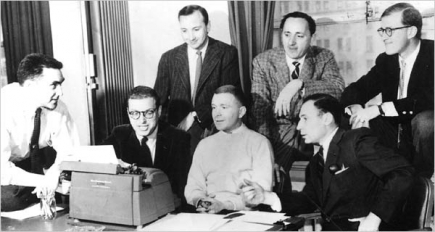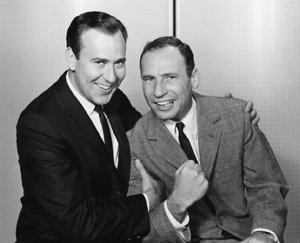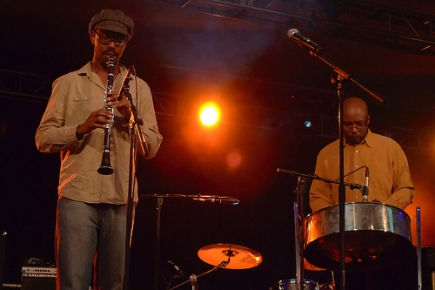Group flow: How teamwork can foster creativity
Researcher R. Keith Sawyer looks to comedians and jazz groups for 10 keys to more creative, successful teams in the office, on the field, and beyond.
In 1949, the comedian Sid Caesar brought together a legendary group of comedy writers and created one of the biggest television hits of the 1950s, Your Show of Shows. Caesar’s team included Mel Brooks, Carl Reiner, and Neil Simon. It may have been the greatest writing staff in the history of television.
They developed the show in a small suite of rooms on the sixth floor of 130 West 56th Street in Manhattan. Caesar created a fun and improvisational environment, where the team would riff on each other’s ideas constantly. “Jokes would be changed 50 times,” Mel Brooks later remembered. “We’d take an eight-minute sketch and rewrite it in eight minutes.” They constantly reworked the same scene until something really great emerged. The writers felt like they belonged to something greater than themselves. Critics and TV historians call this comic gold. I call it “group flow.”
 The legendary writing staff of Your Show of Shows in the 1950s included Mel Brooks (front row, far right) and Neil Simon (back row, far left). Their collaboration epitomizes "group flow."PBS
The legendary writing staff of Your Show of Shows in the 1950s included Mel Brooks (front row, far right) and Neil Simon (back row, far left). Their collaboration epitomizes "group flow."PBS
Famed psychologist Mihaly Csikszentmihaly coined the term “flow” to describe a particular state of heightened consciousness—what some people refer to as being “in the zone.”
Csikszentmihaly discovered that extremely creative people are at their peak when they experience “a unified flowing from one moment to the next, in which we feel in control of our actions, and in which there is little distinction between self and environment; between stimulus and response; or between past, present, and future.” When they enter the flow state, people from a wide range of professions describe feeling a sense of competence and control, a loss of self-consciousness, and they get so absorbed in the task that they lose track of time.
Researchers have spent a lot of time studying how individuals achieve flow, and how it benefits them and their work. But as Mel Brooks and his partners in Sid Caesar’s laugh factory could confirm, sometimes super-creative groups like jazz ensembles, theater troupes, or comedy writing teams get into flow together.
 Carl Reiner (left) and Mel Brooks worked together onYour Show of Shows.
Carl Reiner (left) and Mel Brooks worked together onYour Show of Shows.Indeed, group flow is important for all of us, because so many of our personal and professional activities are spent in groups, and we all want these groups to be more effective and more fun—whether they’re a sports team, a business meeting, a non-profit board, a PTA, or a boy scout troop. Decades of scientific research have revealed that great creativity almost always springs from collaboration, conversation, and social networks—challenging our mythical image of the isolated genius. And research shows that when a group is in flow, it’s more likely to resolve problems with surprising and creative solutions.
So how can business managers, coaches, and the rest of us foster group flow? I first explored this question while working on my Ph.D. with Csikszentmihaly at the University of Chicago. A jazz pianist myself, I started my research by studying jazz ensembles; then, I branched out to study improv theater groups, business teams, and sports teams.
I discovered that group flow isn’t just a matter of luck. Rather, it tends to emerge when 10 key conditions are in place. In these 10 conditions we can find lessons for workplaces, sports teams, and just about any other group that wants its work to be more effective and gratifying.
The keys to flow
To understand the roots of group flow, it helps to understand a bit more about how individuals find flow.
Drawing on research with mountain climbers, club dancers, artists, and scientists, Csikszentmihalyi found that people are more likely to get into flow when their environment has four important characteristics.
First and most importantly, they’re doing something where their skills match the challenge of the task. If the challenge is too great for their skills, they get frustrated; if the task isn’t challenging enough, they simply get bored.
Second, flow occurs when the goal is clear, and third, when there’s constant and immediate feedback about how close you are to achieving that goal.
Fourth, flow occurs when you’re free to fully concentrate on the task.
Building on this research, I found that group flow requires conditions that overlap with and go beyond these four. Here are the 10 factors I identified for group flow.
1. The group’s goal
First, I found that it’s essential for groups to have a compelling vision and a shared mission—they need to be clear about what their collective goal is. But how we define a group’s goal can vary depending on what type of group it is.
Jazz and improv theater are relatively unstructured. The only goal is intrinsic to the performance itself—to perform well and to entertain the audience. This is problem-findingcreativity because the group has to “find” and define the problem as they’re solving it.
But the groups in which we participate during the workday—task forces, project groups, and committees—usually have a specific goal in mind. Business teams are expected to solve specific problems. If the goal is well-understood and can be explicitly stated, it’s a problem-solving creative task.
Problem-finding and problem-solving creativity can both foster flow, depending on the context. Either way, the key to group flow is managing a paradox: establishing a goal that provides focus for the team—just enough focus so that team members can tell when they get closer to a solution—but one that’s open-ended enough for maximum creativity to emerge.
2. Close listening
Actors and musicians both talk about group flow using metaphors like riding a wave, gliding across a ballroom with a dance partner, or lovemaking. Group flow is more likely to emerge when everyone is fully engaged—what improvisers call “deep listening,” in which you don’t plan ahead what you’re going to say, but your statements are genuinely unplanned responses to what you hear. Innovation is blocked when one or more participants already has a preconceived idea of how to get to the goal; improvisers frown on this practice, pejoratively calling it “writing the script in your head.”
Here’s an example from an improv performance with no group flow. A pair of improv actors, a man and a woman, are walking slowly across the stage, hand in hand, taking a romantic walk in the park, when this exchange occurs:
Woman (pointing to the side of the path): Oh look, what’s that?
Man: It’s just a pile of dog poop.
Woman (bending closer to look): No, it’s a lottery ticket!
When the woman pointed to the side of the trail, she was already “writing the script” that they would find a discarded lottery ticket in the park. She was probably already thinking that it would be a winning ticket and that it would change their lives. That “scripting” kept her from listening to what her partner really said and riffing off of that.
3. Keep it moving forward
After deep listening, team members need to keep moving the conversation forward, meaning that they follow the most important rule of improv: “Yes, and…” In other words, listen closely to what’s being said, accept it fully, then extend and build on it. This often leads down an unexpected and improvised path, a problem-finding process that can result in surprising new ideas.
Nothing staunches creativity quicker than negating or ignoring your partner. “Yes, and…” builds on deep listening, and it’s critical to group flow.
4. Complete concentration
In basketball, complete concentration is required because the game moves fast—everyone’s constantly moving around you, and yet you need to remain constantly aware of your teammates and opponents. One of the basketball players Csikszentmihalyi interviewed said, “If you step back and think about why you are so hot all of a sudden, you get creamed.” When a player is in flow, time becomes warped, minutes seem like hours, and the basketball can appear to move in slow motion.
To enable a similar degree of concentration—and flow—in group settings, it helps to wall the group’s work off from other activities, giving them the space to devote their full attention to their work. Perhaps this is why many high-performing groups have a strong feeling of group identity, of standing apart from the world.
5. Being in control
People get into flow when they’re in control of their actions and of their environment. In the same way, group flow increases when people feel autonomy, competence, and relatedness. Many studies of teams have found that if a team knows that their managers trust them and will, in the end, accept and support what they decide, that team performs better.
But in group flow, unlike solo flow, control results in a paradox: Each participant must feel in control while at the same time remaining flexible, listening closely, and always being willing to defer to the emergent flow of the group. The most innovative teams are the ones that can manage that paradox.
 Andy Newcombe/Creative Commons
Andy Newcombe/Creative Commons6. Blending egos
Jazz musicians know that they need to control their egos; every jazz player can tell a story about a technically gifted young instrumentalist who was nonetheless a horrible jazz musician. What they’re lacking is the ability to submerge their ego to the group mind, to balance their own voice with deep listening.
Group flow is the magical moment when it all comes together, when the group is in sync and the performers seem to be thinking with one mind. In group flow, each person’s idea builds on the ones that their partners just contributed. Small ideas build together and an innovation emerges.
“He is animated and engaged with you,” one executive said of a colleague who often participated in groups in flow. “[But] he is also listening and reacting to what you are saying with undivided attention.”
7. Equal participation
Group flow is more likely to occur when all participants play an equal role in the collective creation of the final product or performance. Group flow is blocked if anyone’s skill level is significantly below the rest of the group; all of the members must have comparable skill levels. This is why professional athletes don’t enjoy playing with amateurs: Group flow can’t happen, because the professionals will be bored and the amateurs will be frustrated. It’s also blocked when one person dominates, is arrogant, or doesn’t think they have anything to learn in the conversation.
8. Familiarity
By studying many different work teams, psychologists have found that when we’re more familiar with our teammates, we’re more productive and make more effective decisions. When members of a group have been together awhile, they share a common language and a common set of unspoken understandings—what psychologists call ”tacit knowledge.” Because it’s unspoken, people often don’t even realize what it is that enables them to communicate effectively.
In improv, group flow happens only when all the players have mastered a body of tacit knowledge. Improv actors learn a set of guiding principles that help make it work, rules such as “Don’t deny” and “Show, don’t tell.”
This shared understanding gets group members on the same page about the group’s goals—and clear goals are a cornerstone of group flow. Familiarity with one another’s communication style also helps them respond to each other quickly, and we know from Csikszentmihalyi’s research that immediate feedback is critical to flow.
9. Communication
Indeed, group flow requires constant communication. Everyone hates to go to useless meetings. But the kind of communication that leads to group flow often doesn’t happen in the conference room. Instead, it’s more likely to happen in free-wheeling, spontaneous conversations in the hallway, or in social settings after work or at lunch.
10. The potential for failure
Jazz ensembles rarely experience flow during rehearsal; group flow seems to require an audience, and the accompanying risk of real, meaningful failure. Jazz musicians and improv theater ensembles never know how successful a performance will be. Professional actors learn not to ignore the feeling of stage fright but to harness it, using it as a powerful force to push them toward flow.
Research shows us over and over again that the twin sibling of innovation is frequent failure. There’s no creativity without failure, and there’s no group flow without the risk of failure. These two common research findings go hand in hand, because group flow is often what produces the most significant innovations.

Finding the balance
As this list suggests, group flow happens when many tensions are in perfect balance: between convention and novelty, between structure and improvisation, between the critical, analytic mind and the freewheeling, outside-the-box mind, between listening to the rest of the group and speaking out with your own individual voice. The central paradox of group flow is that it can only happen when there are rules and the participants share tacit understandings, but with too many rules or too much cohesion, the potential for innovation is lost.
The key question facing groups that have to innovate is finding just the right amount of structure to support improvisation, but not so much structure that it smothers creativity. Jazz and improv theater have important messages for all groups, because they’re unique in how successfully they balance all of these tensions.
The most effective business teams balance these tensions in the same way: They listen closely, they are concentrated on the task, they communicate openly so that everyone gets immediate feedback, and they trust that genius will emerge from the group, not from any one member. When that happens, groups find flow—and with it, studies show, comes more effective team performance, greater innovation, and higher workplace satisfaction. It’s good for the organization, and it’s good for its workers, too.
R. Keith Sawyer, Ph.D., a professor of psychology and education at Washington University in St. Louis, is one of the country’s leading scientific experts on creativity. He elaborates on the ideas in this essay in his book Group Genius. A jazz pianist for over 20 years, Dr. Sawyer lectures to corporations, associations, and universities around the world on creativity and innovation. This article was reprinted with permission from the Greater Good Science Center
SHARE YOUR REFLECTION
5 Past Reflections


On Oct 26, 2013 Kandle wrote:
This is exactly exactly the type of ideas we need to incorporate into how we coach teams. Often managers worry about tasks instead of process. And trusting in the process and trusting in the people you hired.

On Feb 13, 2012 bluebuddha wrote:
A lot of great insights to take from this one. Having worked with a lot of dynamic groups, it's interesting to see some of the factors presented here for team work. Thanks!

On Feb 1, 2012 Lindacchilders wrote:
Thanks Dr. Keith, I have seen this work in the business world and understand how sensative that balance is and how quickly it can erode. We'll keep trying to make beautiful music together at my workplace.

On Feb 1, 2012 Georgiabushell wrote:
What a bunch of bull stuff for the weak minded to use as buzz words in some grand speech about bringing the team together. Hot air and fluff.

On Aug 21, 2021 Anna Tasya Cindy Wika wrote:
Amsterdam salah satunya di dunia yang ketinggiannya di dasar permukaan air laut. Ini membuat pengaturan air tertanggal yang sangat berarti di kota ini. sebagian permukaan kota ini adalah kanal dengan panjang lebih dari 100 https://pesona-wisata.com/ kilometer dengan 90 pulau serta 1. 500 jembatan.
Di Belanda, kanal- kanal ini diucap dengan canal belt, berupa gambar melihatan, serta sebagian besar seperti pemukiman penduduk. 3 sungai selalu menjadi destinasi wisata di Belanda di antaranya Herengracht, Keizergracht Prinsengracht, dan masuk ke dalam catatan Situs Warisan Dunia oleh UNESCO.
Post Your Reply